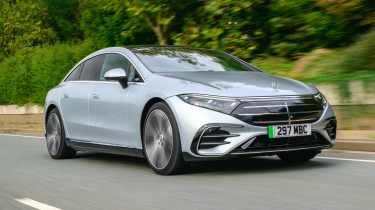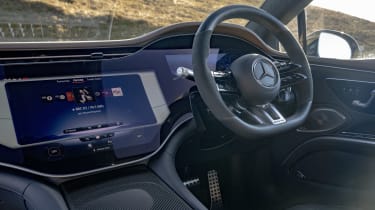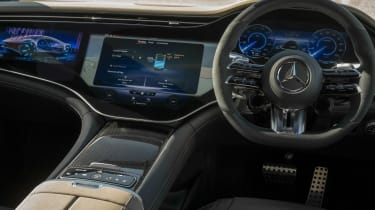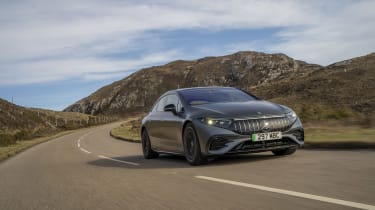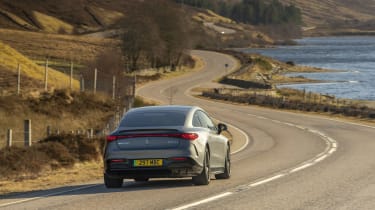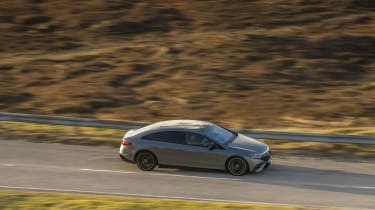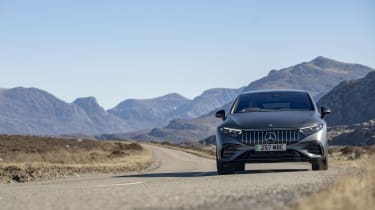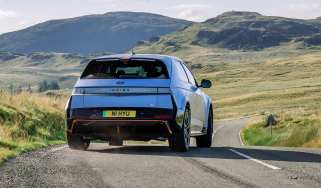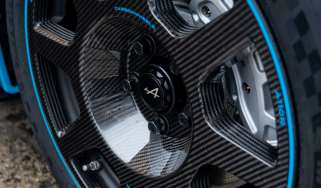Mercedes-Benz EQS 2025 review – electric S-class takes aim at the BMW i7
Mercedes put all of its resources into creating a bespoke all-electric flagship, but it’s not quite worthy of replacing the S-class yet
Planning the first all-electric Mercedes-Benz S-class probably felt like a liberating moment. Engineers were given a blank sheet of paper on which to create the blueprint for an electric version of the most successful and consistently unbeatable luxury saloon car ever sold. An electric S-class built upon its own bespoke platform, with battery and motor technology that promises the holy grail of EVs: strong performance and a long range. The opportunity to integrate driving aid technology like never before, take interior luxury and functionality to another level. Essentially, the brief was to redefine the luxury saloon car.
In reality, this liberating mandate is also an impossible one to pull off, because quite simply, the EQS isn’t on a par with an S-class. Sorry Mercedes. Design is subjective, of course, but the EQS looks a dud in every one of its forms. It lacks the presence of a flagship Mercedes, wears a nondescript face, it looks cheap and confused, neither being a traditional three-box saloon design as per the S-class, nor an on-trend EV hatch – the old school bonnet-mounted three-pointed star emblem is a nice touch, but this doesn’t exactly solve its fundamental flaws. It has the appearance of a car that no one on the design team could figure out how to give it an identity. So they didn’t.
However, there is method behind the design, because EV’s live and die by their aerodynamic properties, so what the EQS lacks in statesman-like presence like that of an S-class, it makes up for by being considerably slippier through the air and therefore more efficient – its 0.20 drag coefficient making it, according to Merc, the world’s most aerodynamic car. Given the range it can achieve, we believe it.
More reviews
Regardless of the poor first impression, technology is never far away from being part of the EQS experience. The door handles slide out of the body to meet you as you approach and if there’s no ambient noise you’ll even hear the distinctive sound of plastic against plastic as they present themselves; door handle quality matters, they are a car’s handshake and the EQS’s is a bit limp. Play with the settings within the EQS’s brain and you can set the door to open on approach and close when you place your foot on the brake pedal.
Interior and tech
Inside is where the EQS gets serious. With a 3-metre wheelbase (the car’s over 5-metres long) you don’t know whether to sit in the back and enjoy the long wheelbase S-class-beating leg room, or jump in the front. In the back there’s more room than most will know what to do with, but the combination of a high floor (thanks to its massive 107kWh (usable) battery) and a low seat squab means it’s not as comfortable as it looks, missing that sense of sinking into the car to relax – taller passengers will notice the steep angle of the roof at the rear which makes for a noticeable reduction in headroom over conventional alternatives.
In the EQS 450 'Business Class' we sampled, the rear passenger experience is impressive nonetheless. The aforementioned fundamental ergonomic issues remain, but impressive attention to detail and tech make it feel like a special place to be. There’s a dedicated button in the rear to fold the front passenger seat flat for even more leg room (if your driver doesn’t mind not being able to use the left hand wing mirror), optional moveable cushions and some very impressive lighting features.
As with any modern Mercedes, there’s a strong focus on ambient lighting, but in the EQS it’s taken to the extreme. While you can make it as garish as you’d like, the quality way in which each lighting element is diffused makes it feel a step above other implementations. Animated effects are also a nifty addition, if a gimmick, and Mercedes has even gone so far as to give the rear passenger the ability to alter the colour temperature of the dedicated reading light via the central removable tablet.
Up front your world is dominated by screens, three of them. Both the 450+ and EQS53 we tried were equipped with the mammoth £7000+ hyperscreen option, which includes a digital display for the driver, an additional screen for the passenger that allows them to do things from their seat… that they can also do via the 17.7-inch central screen (as well as watch a movie). At first glance it looks impressive, a continuous clean surface wrapping around the cockpit, but in the daytime you can see square edges of the screens hidden behind that flush glass frontage. It’s a detail that needs more time in the design stage, but in the rush to bring EVs to the market it’s a small detail that’s a big distraction.
It’s through this central screen that the entire car pretty much functions, eradicating as many buttons as possible, apart from on the steering wheel, which still has plenty. Sadly, it suffers from the same bugbears pretty much every system of its type does: the voice recognition is good for some very specific commands, but it’s otherwise useless, and the controls for the assistance systems involve a game of hide and seek to switch off and the majority are operated through a touch screen with reaction times only it understands.
So the tech in the EQS can be frustrating, but the materials and fit and finish are of more concern, because neither are good enough for a car costing six-figures. There’s some nice unvarnished wood that’s beautifully tactile to touch and adds a far superior ambience than the highly polished plastic wood veneers German manufacturers usually turn to. The leather that is used is also plush, soft to the touch and tightly stitched but unfortunately much of the cabin is trimmed in plastic made to look like leather, and in places it’s as convincing as a 12-year old telling you they haven’t taken their phone to bed with them.
A lack of in-wiper sprayers (something a c1100kg Alpine A110 takes advantage of) and an oddly high seating position are among the other quirks we noticed, but the overall impression is one of a premium car, if not an S-class alternative. Features such as the headlights are some of the best on the market, and unlike some EVs, its boot capacity is impressive.
Powertrain and technical highlights
Underpinning the EQS is a bespoke electric platform that serves as a base for both equivalent electric SUVs and the smaller EQE, the company’s electric E-class. Between the axles sits a monstrous 107.8kWh (usable) battery, which means when fully charged you’ll see a WLTP range of 453 miles, which shuts up most EV sceptics who bang on about such things. Although with a 2480kg kerb weight (2605kg for the EQS53) you can chew through that range if you decide to put the 450+’s 329bhp to good use through its single rear-motor. Start to play with the 53’s 648bhp that’s delivered to all four corners – or 751bhp with the AMG Dynamic Plus Package option ticked, which our car had along with 752lb ft of torque – and you’re looking at its claimed 358 mile range dipping into the two hundreds as quickly as it reaches 62mph (3.8sec since you asked).
Neither variant is anything to write home about to drive. The driving position doesn’t feel quite right, you’re sat too high on the seat, but then not quite high enough to see over the vast instrument display which means you constantly fiddle with the seat controls hunting for some ergonomic equilibrium that fails to materialise. Go too high and you’ll then come into contact with the windscreen header rail – it’s an astounding oversight in basic packaging. Bespoke EVs were meant to be the ultimate free pass for packaging engineers, right?
Yes, the EQS53 is quick, but to what gain? It’s not a car that fills you with encouragement to exploit and you’ll never advance beyond point and squirts between corners because it’s so big, heavy and offers little reward for doing so. But despite its badging it’s also not a performance car, so we shouldn’t expect it to behave like an E63 S either. Which begs the question: what actually is it? In AMG form it’s bettered by existing AMG products and outside of Mercedes, Porsche’s Taycan walks all over it in terms of how it drives.
Performance, ride and handling
The 53 benefits from being marginally stiffer, which improves body control and reduces the flex you can feel through the body and chassis. But it’s a car that feels like it’s having a fight with itself, the technology unable to calculate what’s required to combat good old fashioned physics that results from two and half tons of metal, glass and electric cabling combining to produce a substantial mass that constantly needs tying down.
This unsettled nature doesn’t make for a very relaxing drive or ride. In the AMG, the steering feels quite nervous for a car designed to be calming. It’s quicker than you think it’s going to be on turn in, a feeling exaggerated by the four-wheel steering playing a significant role to shorten that long wheelbase and manage that mass. When it comes to braking and the car’s regenerative system (controlled by the paddles behind the steering wheel with three distinct settings), the brake pedal sinks to mimic the braking action, so when you need to step in and increase the retardation, the pedal isn’t where you expect it to be. So you stamp on it in a panic and put the car on its nose. It’s just another frustrating example of the car feeling a couple of hundred thousand kilometres short of its final sign off.
The EQS 450 we tried is very tail happy on cold, damp roads should you decide to use its modest performance, but perhaps this shouldn’t be a surprise given its single, rear-mounted motor. Even in this form though, power is more than adequate for the task at hand and with a well calibrated throttle, it’s a satisfying car to drive efficiently and smoothly. Range is as impressive as you’d expect from such a slippery car with such a large battery, even in cold weather and at motorway speeds – the range estimation and handy power gauge on the dash help eliminate any potential range anxiety.
The EQS has extremely light steering as with most cars of this kind, but while its aggressive rear-wheel steering can make low speed manoeuvring a little unintuitive at first, it’s confidence inspiring when you increase the speed. Get your head around the technology to find your preferred presets, and the EQS 450 is a supremely relaxing car to drive.
It’s impressively quiet, too, which you’ll probably be expecting from those who have spent decades perfecting the S-class ambiance, but probably not to this level of calmness. Every external noise is squashed, even the roar from its 22-inch tyres is silenced. But… it doesn’t exude the confidence of an S-class, lurching and heaving on trickier roads, with low profile tyres allowing some higher frequencies into the cabin.
Price, specs and rivals
The Mercedes-Benz EQS currently starts at £99,845 for the 350 AMG Line, giving you a single motor mounted at the rear for just shy of 300bhp, a spritely 6.5sec 0-62mph time and over 400 miles of WLTP range. Opt for the 450+ for a c50bhp bump in output and you'll pay from £112,620, adding standard kit, performance and increasing the battery size for a 480-mile WLTP range. Various trim options are available throughout the range to bring more standard kit to the table... of which there is a lot.
As a luxury car the smaller Porsche Taycan (from £88,200) has the EQS covered in terms of interior quality and dynamics, but the Mercedes does have some tricks up its sleeve. Build quality could be better and its design is certainly not its strong point, but for those after a car chock-full of tech that can (very) comfortably carry four people over 400 miles on a charge, there’s not much better for the task.
That’s assuming you’re only willing to buy electric, as the S-class still exists, and is still the best of its ilk this side of a Bentley Flying Spur. There’s a good car in the EQS, after all something called the Word Car of the Year named it their luxury car of the year, but this car feels very first generation, where rivals like the BMW i7 (from £101,775) definitely do not.
